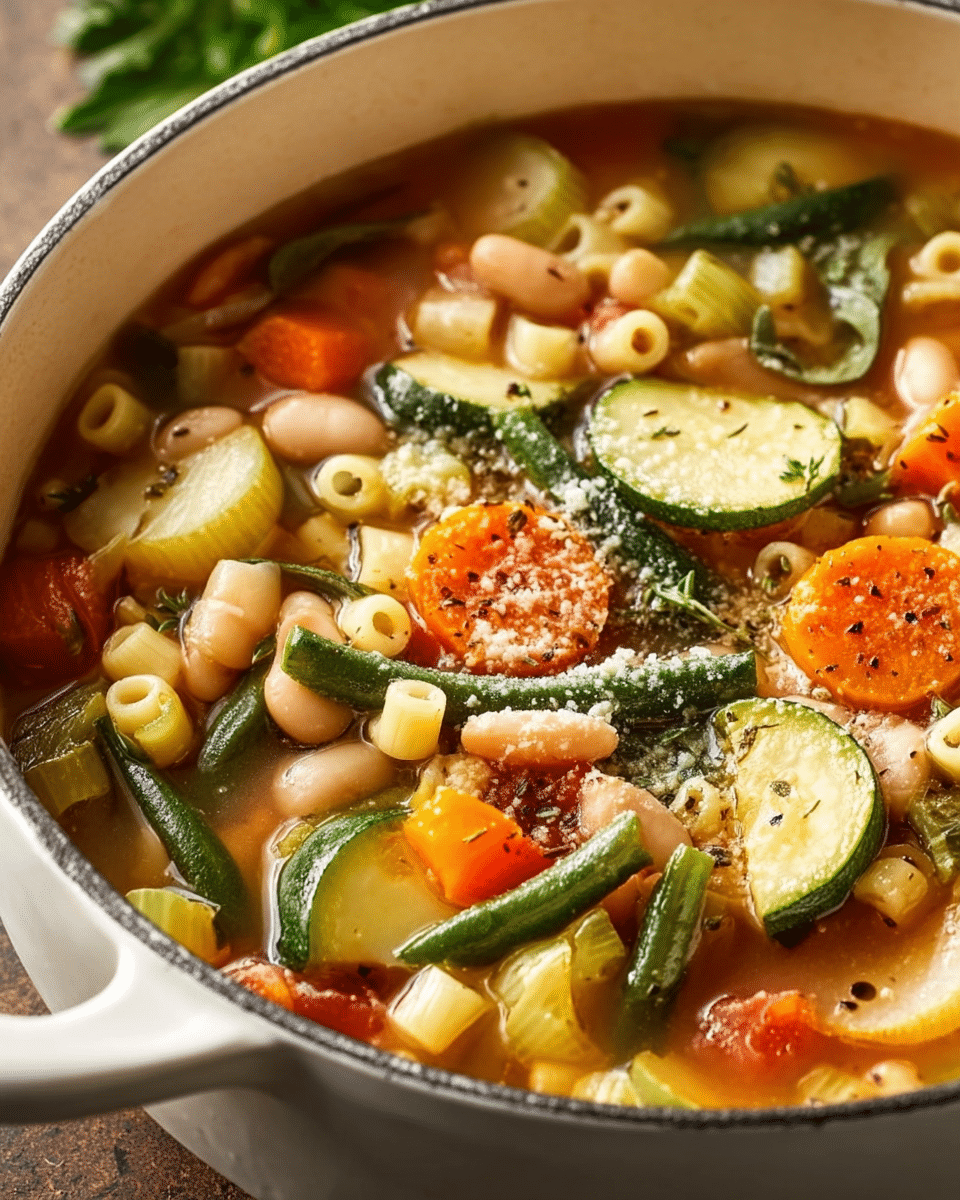The freshness of spring is captured in every spoonful of this light and vibrant Spring Minestrone Soup. Brimming with seasonal vegetables like asparagus, peas, and zucchini, it’s a celebration of green goodness and garden-to-bowl cooking. The lemony brightness and soft herbs balance the earthy cannellini beans and pasta, creating a dish that’s as nourishing as it is beautiful.
This is a perfect recipe for the transition months, where the weather begins to warm but you still crave something comforting. Serve it with a slice of crusty bread or a fresh green salad, and you’ve got a complete, satisfying, and deeply wholesome meal that reflects the very best of spring. It’s a stunning centerpiece for brunches, weeknight dinners, or light Sunday suppers.
Full Recipe:
Ingredients:
-
2 tablespoons olive oil
-
1 leek, sliced
-
2 garlic cloves, minced
-
2 carrots, diced
-
1 zucchini, diced
-
1/2 cup green beans, trimmed and halved
-
1 cup asparagus tips
-
1/2 cup frozen peas
-
1 can (15 oz) cannellini beans, drained and rinsed
-
1/2 cup small pasta (ditalini or orzo)
-
4 cups vegetable broth
-
2 cups water
-
Salt and pepper to taste
-
Juice of 1 lemon
-
1/4 cup chopped fresh basil
-
1/4 cup grated Parmesan cheese (optional)
-
2 tablespoons pesto, for garnish (optional)
Directions:
-
Heat the olive oil in a large soup pot over medium heat. Add the sliced leeks and sauté for 2–3 minutes until soft and fragrant.
-
Stir in the garlic, carrots, and zucchini. Cook for 4–5 minutes until vegetables begin to soften.
-
Add the green beans, asparagus, peas, and cannellini beans to the pot. Stir gently to combine.
-
Pour in the vegetable broth and water. Bring the soup to a boil, then reduce heat and simmer for 10 minutes.
-
Add the pasta and cook for another 8–10 minutes, or until the pasta and all vegetables are tender.
-
Season with salt, pepper, and lemon juice. Stir in chopped fresh basil just before serving.
-
Optional: Serve hot with a spoonful of pesto and a sprinkle of grated Parmesan cheese.
Prep Time: 10 minutes | Cooking Time: 25 minutes | Total Time: 35 minutes
Kcal: 275 kcal | Servings: 4 servings
When the air begins to warm and the earth awakens with vibrant greens, it’s time to transition from the hearty stews of winter to the fresh, invigorating flavors of spring. One dish that beautifully captures the spirit of the season is Spring Minestrone Soup. This lighter take on the classic Italian favorite showcases the best produce of the season delicate vegetables, leafy herbs, and a broth that feels both comforting and revitalizing.
Unlike its winter counterpart, which often features heavier legumes, potatoes, and tomatoes, spring minestrone is all about brightness, color, and garden freshness. It’s the ultimate celebration of seasonality, simplicity, and the timeless appeal of rustic Italian cuisine.
The Roots of a Seasonal Classic
Minestrone originates from Italy and is one of the oldest and most traditional soups in Italian cooking. The name itself means “big soup,” referencing the abundance of ingredients and its hearty, flexible nature. Historically, minestrone was a “poor man’s meal,” assembled from whatever vegetables were in season, sometimes thickened with pasta or rice, and often without meat. That versatility is exactly what makes it a timeless favorite across generations and continents.
Spring minestrone carries forward the same philosophy but focuses on tender spring vegetables such as peas, zucchini, asparagus, green beans, and fresh herbs. While it can still include beans and pasta, the overall character is much lighter, both in texture and appearance. It’s not just a variation of a soup it’s a seasonal expression of life, growth, and renewal.
Why Spring Minestrone Is Special
A Tribute to the Season
Spring minestrone is more than just a bowl of soup. It’s a way to taste the season. With its emphasis on newly harvested vegetables, it invites you to shop locally, visit farmers markets, and cook in harmony with nature. Each ingredient has a purpose not only for flavor, but for the feeling it evokes. The result is a soup that’s subtly sweet from young carrots and peas, refreshing from a squeeze of lemon juice, and balanced by the richness of beans or a swirl of pesto.
Light Yet Satisfying
Though it’s considered a “light” soup, spring minestrone is surprisingly satisfying. The inclusion of pasta or small grains like orzo or farro offers a chewy bite, while beans provide plant-based protein and fiber. This makes it a fantastic meal on its own or a beautiful first course to a springtime dinner. For those looking for healthier meal options, this soup is naturally low in fat, high in nutrients, and adaptable for vegetarian or vegan diets.
Visually Stunning
Few soups can boast the visual appeal of spring minestrone. A vibrant palette of green dominates the bowl, thanks to spinach, zucchini, and herbs, punctuated by the ivory of cannellini beans or pasta. A spoonful of bright green pesto or a shaving of parmesan over the top creates a dish worthy of social sharing and dinner parties alike. It’s rustic and elegant all at once.
Health Benefits of Spring Minestrone
Spring minestrone is a nutritional powerhouse. By including a medley of fresh vegetables, legumes, and herbs, it delivers:
- Vitamins A, C, and K from leafy greens and carrots
- Plant-based protein from beans
- Complex carbohydrates from whole grains or pasta
- Fiber to support digestion and satiety
- Antioxidants from garlic, leeks, and olive oil
- Healthy fats if topped with pesto or a drizzle of extra virgin olive oil
This combination makes it ideal for anyone following a Mediterranean-style diet, looking to boost their immune system, or simply trying to enjoy healthier meals without sacrificing flavor.
Customization and Versatility
One of the reasons this dish is so beloved is its adaptability. You can tailor it to your tastes, what you have in your pantry, or even dietary restrictions. Here are a few popular variations:
- Vegan Version: Skip the parmesan and use a dairy-free pesto or none at all.
- Gluten-Free Version: Substitute gluten-free pasta or add cooked quinoa instead.
- Protein Boost: Add grilled chicken, shredded turkey, or even a poached egg on top.
- Extra Greens: Toss in spinach, kale, or chard during the last minute of cooking.
- Flavor Enhancers: Stir in lemon zest, chili flakes, or a dash of white wine for complexity.
Every home cook brings something unique to their minestrone, and spring offers a chance to explore light, aromatic, and herb-forward flavors.
Serving Suggestions
Spring Minestrone Soup shines as the centerpiece of a healthy lunch or a starter for a festive spring gathering. Here are a few ways to serve it:
- With a toasted slice of sourdough or baguette, rubbed with garlic and olive oil.
- Alongside a spring salad of arugula, radish, and lemon vinaigrette.
- As a starter course before a main dish of grilled fish or roasted chicken.
- Chilled slightly for a cool spring lunch, especially if the weather warms up.
- Garnished with fresh basil, microgreens, or edible flowers for a show-stopping presentation.
The beauty of this soup is that it feels equally at home in a casual weeknight dinner or a stylish Sunday brunch.
Tips for the Best Spring Minestrone
- Don’t overcook the vegetables. The key to maintaining that fresh, crisp texture and vibrant color is to add the most delicate vegetables near the end of cooking.
- Use homemade or high-quality broth. Since the broth carries the base flavor, opt for homemade vegetable or chicken broth if possible.
- Add citrus at the end. A squeeze of lemon or a little zest can brighten up the entire dish without overpowering the subtle sweetness of spring veggies.
- Balance your textures. A mix of creamy beans, al dente pasta, and just-tender vegetables keeps every bite interesting.
- Finish with fresh herbs. Basil, parsley, and chives add freshness and bring out the best in your vegetables.
A Dish Worth Revisiting
Spring Minestrone Soup isn’t just a recipe you make once and forget. It’s a seasonal staple that evolves year after year. One spring you might use fresh peas and asparagus; another, you may experiment with wild ramps, snap peas, or even fresh fava beans. It’s a living, breathing dish that changes as the landscape does.
Many cooks also use this soup as a “reset” meal perfect after indulgent holidays or heavy meals. It helps you return to the basics: real food, slow cooking, and mindful eating.
Conclusion: A Bowl of Renewal
Spring Minestrone Soup is more than the sum of its parts. It’s an ode to freshness, to thoughtful cooking, and to honoring the rhythms of nature. With every spoonful, you taste brightness, balance, and care elements often lost in fast, processed foods. It invites us to slow down, reconnect with our kitchens, and enjoy the simple beauty of seasonal ingredients.
Whether you’re feeding a family, cooking for one, or preparing a meal for friends, this soup fits every occasion. It is, at once, grounding and uplifting just like spring itself.
So the next time you stroll through your local market or garden and see the tender greens of the season, let Spring Minestrone Soup be your invitation to celebrate them in the most nourishing way possible.






